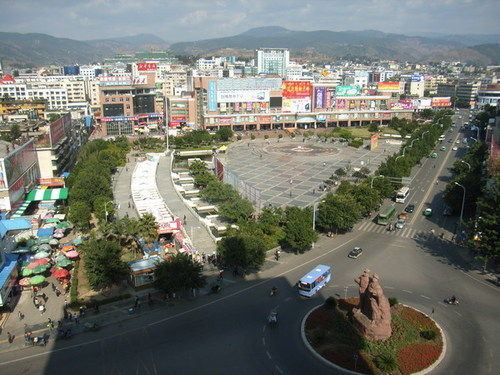Area 2,651 km2 | ||
 | ||
Country Peoples Republic of China | ||
Map of Xichang
Xichang, formerly known as Jiandu and Jianchang, is a city in and the seat of the Liangshan Yi Autonomous Prefecture, in the south of Sichuan Province, China. In 2012 it had a population of 481,796.
Contents
- Map of Xichang
- Yaan xichang highway part of china g5 interstate animation demo
- Geography
- Climate
- History
- Transportation
- Spaceport
- Ya an xichang expressway
- References
Yaan xichang highway part of china g5 interstate animation demo
Geography
Xichang lies in a mountainous region of far southern Sichuan. The city is just northeast of the prefecture-level city of Panzhihua. The Anning River is the main river in the area. It is an affluent of the Yalong, Jinsha, and Yangtze rivers. It lies near Qionghai Lake.
Climate
Owing to its low latitude and high elevation, Xichang has a monsoon-influenced humid subtropical climate (Köppen Cwa) milder and far sunnier than the Sichuan Basin, with mild, very sunny and dry winters, and very warm, rainy summers. The monthly 24-hour average temperature ranges from 9.9 °C (49.8 °F) in January to 22.6 °C (72.7 °F) in July, and the annual mean is 17.15 °C (62.9 °F). Over 60% of the 1,010 mm (40 in) annual precipitation occurs from June to August. With monthly percent possible sunshine ranging from 36% in September to 72% in January, the city receives 2,367 hours of bright sunshine annually.
History
The Qiongdu were the local people at the time of contact with China. The county of Qiongdu is attested in the area from the Han dynasty. Under the Song, a local lord was given the title of "King of the Qiongdu" (Qiongdu Wang). The area formed part of the medieval Kingdom of Dali and was subdued by the Mongolians from 1272–4, after which it was incorporated into Yunnan Province of the Yuan Empire. It was organized as the Jiandu Ningyuan duhufu, qianhufu, or wanhufu but continued to be often known as Jiandu. In the book of his travels, Marco Polo recorded that the people of Jiandu and its hinterland used no coins but rods of gold bullion reckoned in saggi. Small change was made using half-catty pieces of molded salt, each reckoned as one-eightieth of a saggio of pure gold. Under the Qing, it was officially known as Ningyuan Commandery but also continued to be referenced under the old name Jianchang. In the 19th century, it was the center of Sichuan's production of "white wax".
Transportation
Xichang Railway Station (西昌站) is a main station on the railway line Kunming - Chengdu. Construction of a fast express train line has been completed, and has considerably shortenened travelling times to Panzhihua, Chengdu and Guangyuan. There are also some other stations in the city, including the Xichang North railway station and Xichang South railway station.
The city possesses its own airport, Xichang Qingshan Airport, which is attached to the spaceport by a railroad line and a motorway directly.
Xichang lies on the Kunming–Chengdu Motorway.
Spaceport
Xichang's spaceport is located about 64 kilometres (40 mi) northwest of the city and went into operation in 1984. Communications satellites are the most common payload to be inserted into orbit from the Xichang spaceport. A number of Long March 3 rockets have been launched from the spaceport.
On January 26, 1995, a Long March 2E rocket veered off course two seconds after take-off from the spaceport and exploded, killing at least six on the ground. On February 14, 1996, a similar failure occurred during the launch of Intelsat 708. The rocket veered severely off course right after clearing the launch tower and landed in a rural village. Xinhua News Agency initially reported six deaths and 56 injuries. The number of civilian deaths has been disputed.
